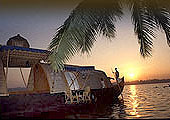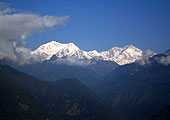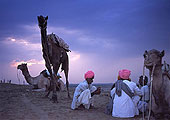Bihar
Bihar is intimately known as Buddhist circuit of India. In 6th Centaury BC, Bihar was marked a blazing trail of Buddhism religious philosophy and thoughts and mind of the populace. Hindu (Jainism) and Buddhist are the 2 religion which brought Bihar in lime light in old world religious aspects. Bihar is derived from the world ’vihara’, which means Buddhist monastery. The temples in these states have a dazzling past. Most of them are predate the Aryan influx, while others are combined with the Vedic pantheon. Various Puranic legends refer to Bihar as a venue for several such events. The Jain and Buddhist temples, monasteries, mausoleums, minars and mosques are the ideal example to follow. The state offering an idyllic escape from the limitations of city life. This is the place of serendipity.
The Buddhist trail commenced and flourished at Patna, the capital city of Bihar. Where a notable museum contains a collection of Buddhists and Hindu sculptures. In the South of Patna is Nalanda is one of known Buddhist pilgrim place, which translates as ’the place that confers the lotus’. A monastic and huge university flourished here from the 5th to the 11th century. Chotanagpur - oldest geological formation of India at Nalanda - the world's most ancient seat of learning; another known Buddhist place in Bihar is Rajgir, ‘the royal palace’, was the site for the first Buddhist Council. The Buddha spent 5 years at Rajgir after having attained enlightenment and many of the remains at Rajgir commemorate various happenings. Bodhgaya is the spot where Buddha attained enlightenment in the Mahabodhi Temple, Bihar’s Buddhist circuit is most sough after places for history, pilgrimage and Buddhism followers. Bihar also offers wildlife sanctuaries, famous Sonepur Cattle fair, tribal destination Chotanagpur, Bihar is also quite known for Madhubani paintings and Patna Qalam, the sheer expressions of people's sensitivity in Bihar. Truly a versatile state for tourism.
Patna

Patna, the capital city of Bihar. The dusty and highly populated city of Patna of today, in ancient time this the most esteemed seats of political power and religion of Hindu and buddhist in ancient India, this was the historical capital of the mighty Mauryan and Magadh rulers. Once called Pataliputra known as world’s oldest capital cities with golden past. A very fertile arched stretch of place located at the bank of holy Ganga river, the heritage and history of modern day Patna go back well over two millennia. It was Ajatshatru the Magadha king who first built a fort in Pataligram on the bank of the Ganga in 6th century BC, which later flourished into the ancient glory still to be seen in the neighbouring archaeological place at Kumrahar. Bhiknapahari, Bulandi Bagh, Agamkuan, and Kankar Bagh. Pataliputra dominated the political influence of the whole region of north India during 6th century BC and 5th century AD, a fact established by archaeological excavations. Patna reached the zenith of its glory during the reign of Great King Ashoka, who was follower of Buddhism. The city was the centre of supremacy till the regime of the Gupta era, later it started languishing rapidly, for a long period. It was revived by Mughal emperor Sher Shah Suri, after which the city became the capital of the Bengal province. After the decline of the Mughals rulers, the British found Patna a convenient regional capital and built a modern expansion n to this ancient city and called it Bankipore.
Altitude: 53 metres. Temperature: (Max./Min.) Summer 43 Deg C/21 Deg C. Winter 20 Deg C/6 Deg C. Rainfall: 120 cms. Best Season: Clothing: Summer- Cottons, Winter- Heavy Woolens. Best Season: October to March.
Places Of Interest:
Agam Kaun, Patna Planetorium, Hanuman Mandir, State Secretariat Building, Patna Museum, Golghar, Darbhanga House, Phulwari Shareef, Gandhi Maidan, Qila House, Takht Shri Harmandir Saheb, Shaeehe Smarak, Padre ki Haveli.
Excursions:
Bodhgaya- 130 kms, Nalanda- 90 kms, Rajgir- 102 kms, Sonepur- 25 kms, Sasaram- 148 kms, Vaishali- 55 kms, Gaya- 110 kms.
Reach -
By Air: Patna is well connected by air with Mumbai, Kolkata, Delhi, Bangalore, Lucknow and Ranchi.
By Rail: Patna is well connected by rail to most of the important cities of India like Mumbai, Kolkata, Guwahati, Ranchi, Varanasi, Siliguri.
By Road:An excellent road network links Patna to major cities like Nalanda- 90 kms, Pawapuri- 90 kms, Raxaul- 210 kms, Ranchi- 335 kms, Muzzafarpur- 72 kms, Sasaram- 152 kms, Vaishali- 56 kms, Calcutta- 653 kms, Delhi- 997 kms.
Vaishali
Vaishali today is a small village known for its historical past. The epic Ramayana tells the story of the heroic King Vishal who ruled here. Historians maintain that one of the world's first democratic republics with an elected assembly of representatives flourished here in the 6th century. Vaishali, on the left bank of the Gandak river, is spiritually supreme : Lord Buddha visited this place frequently and at Kolhua, close by, preached his last sermon. One of the famous lion pillars have been erected here by Emperor Ashoka. A hundred years after the Mahaparinirvana of the Buddha - Vaishali hosted the second great Buddhist council. Jainism, too, has its origins in Vaishali, for in 527 B.C., Lord Mahavir was born here and lived in Vaishali till he was 22. Vaishali is then twice blessed and remains an important pilgrim centre for both Buddhists and Jains and other religions also.
Altitude: 52 metres. Temperature: (Max./Min.) Summer 44 Deg C/21 Deg C. Winter 23 Deg C/6 Deg C. Rainfall: 120 cms. Best Season: October to March.
Places Of Interest:
Ashoka Pillar at Kolhua, Buddha Stupa I, Buddha Stupa II, Raja Vishal Ka Ghar, Coronation Tank, Museum, Bawan Pokhar Temple and Harikatora Temple, Miranji Ka Durgah, Kundupur.
Excursions:
The Jain Prakrit Institute offers a place of study for researchers interested in Jainology an Prakrit, one of the spoken languages of Northern India in ancient times.
Reach -
By Air: Nearest airport is Patna, connected to Bombay, Calcutta, Delhi, Ranchi and Lucknow.
By Rail: Nearest railhead is Hajipur.
By Road: Patna- 55 kms, Muzaffarpur- 36 kms and Hajipur- 35 kms.
Baidyanath Dham (Deoghar)
Baidyanath Dham situated in the Santhal Parganas of Bihar, is a very important pilgrim Centre. It's famous for the Hindus for the temple of Shiva-Baidyanath and the place is a popular holiday Centre.
Temperature (deg C): Summer- Max 36.9, Min 23. Winter - Max 27.7, Min 7.4. Best Season: October to February.
Places Of Interest & Excursions:
Baidyanath Temple, Nandan Pahar, Naulakha Mandir, Satsang Ashram, Tapovan, Basakinath Temple, Harila Joria, Trikut, Bihar State Handloom Emporium, Santhal Parganas Gramodyog Samittee, Santhal Parganas Khadi Gramodyog Bhavan, Balanand Ashram Yogashala, Karnibagh.
Reach -
By Air: Nearest Railway Station is Baidyanath Dham (Deoghar) which is a terminal station of a 7 kms branch line originating from Jasidih Jn.
By Rail: Calcutta- 373 kms, Giridih- 112 kms, Patna- 281 kms, Dumka- 67 kms, Madhupur- 57 kms, Shimultala- 53 kms.
Gaya
Bihar has some of the most sacred Buddhist and Hindu shrines. Gaya is one of the most important pilgrimage places for the Hindus. It is believed that a Hindu will reach heaven if his last rites are offered under the celebrated ’Akshayabat’ or immortal banyan tree, standing in the yard of Vishnupad temple. Believed to be built on the footsteps of Vishnu, the grand temple was renovated by Ahalyabai, queen of Indore.
Excursions: Brahma, Deo, Barabar caves, Pawapuri, Parasnath hill, Call of the hills, Ranchi, Hazaribagh, Netarhat, Palamau, Jamshedpur, Damodar Valley, Dhanbad, Bhagalpur, Monghyr.
Reach - Gaya is an important railway junction.
Bodhgaya
Bodhgaya is Located in Bihar State, Bodhgaya (also written Bodh Gaya) is popular of the Buddha's enlightenment and the holiest of four major Buddhist and Hindu pilgrimage destinations. Also known as Uruvela in the Buddha's era, now Bodhgaya is now a town of about 30,000 populations. Mahabodhi Temple and the Bodhi Tree are the 2 major sacred sites of Bodhgaya. Around both places are other temples and monasteries of Buddhist religion and traditions, (Tibetan, Bhutanese, and Japanese). This places is visited by millions of buddhist pilgrims specially from Asian countries, visit to Bodhgaya to be inspired, dissipate negative earn merit and karma by visiting the religious places, Here under the Bodhi Tree, Gautama attained supreme knowledge to become Buddha, the `Enlighted One'. This still stands in the temple complex. The glorious Mahabodhi temple in Bodhgaya is an architectural amalgamation of many centuries’ cultures and heritages. The temple built wonderful architecture of the Gupta and later ages, inscriptions describing visits of pilgrims from China, Sri Lanka and Myanmar. During the season, you will find followers and monks in colorful robes meditating where the Buddha did, studying dharma texts, making offerings and prayers to the many stupas, and circumambulating (walking around) the sacred Mahabodhi Temple.
Altitude: 113 metres. Climate (deg c): Summer- Max.47, Min.28. Winter- Max.28, Min.4. Rainfall: 186 cms ( Mid. June to Mid. September ). Best Season: October to March.
Places Of Interest:
Bodhi Tree, Mahabodhi Temple, Archaeological Museum, Tibetan Monastery, The Burmese Temple, Animeshlocan Chaiyata, Mohanta's Monastery, Ratnagar, Thai Temple & Monastery, International Buddhist House & Japanese Temple, Buddhist Monastery of Bhutan, The Chinese Temple & Monastery.
Excursions:
Rajgir – 77 kms, Gaya- 12 kms, Nalanda -77 kms, Majadha University- 3.2 kms, Muchalinda Lake- 3 kms, Dungeshwari- 12 kms.
Reach -
By Air: Gaya located at a distance of 12 kms is the nearest airport to reach Bodhgaya. Located at a distance of 130 kms, Patna airport is another airport which is well connected to Mumbai, Delhi, Ranchi, Lucknow & Kolkata.
By Rail: Gaya is the nearest railway station located at a distance of 12 kms which is a major railhead and there are trains to Gaya from many destinations of India.
By Road:Bodhgaya is well connected by road to most of the cities of Bihar which include Gaya- 12 kms, Nalanda- 62 kms, Rajgir- 46 kms, Patna- 130 kms, Varanasi- 215 kms, Calcutta- 482 kms.
Nalanda
Founded in the 5th century A.D. Nalanda is known as the ancient seat of learning. World's most ancient University lies in ruins which is 62 kms from Bodhgaya and 90 kms south of Patna. Emperor Ashoka built many monasteries, temples and Viharas here. Hiuen Tsang stayed here in 7th century and has left detailed description of the excellence of education and purity of monastic life practiced here. In this first residential international university of the world, 2,000 teachers and 10,000 students from all over the Buddhist world lived and studied here. The Gupta kings patronised these monasteries, built in old Kushan architectural style, in a row of cells around a courtyard. Ashoka and Harshavardhana were some of its most celebrated patrons. An international Centre for Buddhist Studies was established here in 1951. Nearby is Bihar Sharif, where an annual urs is celebrated at the Dargah or tomb of Malik Ibrahim Baya. Baragaon, The Sun temple is famous for Chhath puja.
Altitude: 67 metres. Temperature (deg C): Summer- Max. 37.8, Min. 17.8. Winter- Max.27.8, Min.10.6.


















































































